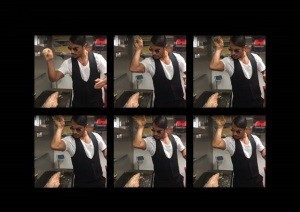Contact
November 26, 2018
In March 2017 the Turkish chef Nusret Gökçe applied to register the following motion mark, showing him elaborately sprinkling salt on a piece of steak by letting it fall down his forearm, which he claimed was a unique technique, and which had received a great deal of attention online:

The application was for goods and services in Classes 25 (clothing), 30 (coffee, cocoa, and other food and drink), and 43 (services for providing of food and drink).
In October 2017 the EUIPO examiner partially refused the application under Article 7(1)(b) of the EU Trade Mark Regulation (2017/1001/EU), finding that the mark was devoid of any distinctive character in respect of services in Class 43. The examiner said that the mark would be seen by the relevant public as nothing more than a banal and ordinary scene of a chef preparing meat with a pinch of salt. In December 2017, Mr Gökçe appealed to the Board of Appeal.
Considering distinctive character, the 5th Board of Appeal (BoA) said that it did not agree with the extent of the examiner’s objection in relation to some of the services in Class 43. The process of salting meat was a necessary step in the preparation of most meat-based meals, the BoA said, and people use different practices: some salting early on in the process and others leaving it to later. Whatever the practice chosen, the BoA said, the process was very normal and standard practice within the world of cooking. Therefore, the motion mark applied for could not be registered for services relating to the provision of food. However, in relation to the other services claimed, such as “services for providing of drink; rental of food service equipment used in services providing food and drink; reservation of temporary accommodation, rental of banquet and social function facilities for special occasions, namely, wedding receptions, conferences and meetings”, the Board agreed with Mr Gökçe that the mark was distinctive.
In terms of the objected services, the BoA said that the relevant public would perceive the mark as nothing more than a chef preparing food. There was nothing fanciful, imaginative or striking in the mark that would create a link in the consumer’s mind between the sequence of the chef salting the piece of meat and the services applied for. The mark would not provide them with any specific information or clear message regarding the commercial origin of the services. The mark was not, therefore, able to fulfil its essential function.
Mr Gökçe claimed that the arm’s movement in the mark was original and had been a success on the internet making him internationally known. The BoA disagreed, as the mark applied for consisted of a chef salting a piece of meat and the arm’s movement was not the mark itself.
As for acquired distinctiveness, the BoA noted that Article 7(3) not only required intensive use of the sign by the applicant, but went much further. As a result of use, the sign, which was originally unable to fulfil the function of indicating origin, must be shown to now perform that function. The ability of the relevant public to identify the goods/services as originating from a particular undertaking must be as a result of the use of the sign as a trade mark, and therefore as a result of its nature and effect, which made it capable of distinguishing the goods/services concerned from those of other undertakings.
Mr Gökçe produced evidence of references to well-known social media sites, including Twitter, YouTube and Instagram, as well as articles from various UK newspapers and a Wikipedia print out, which referred to a viral video from Mr Gökçe’s Twitter account.
The BoA noted that claiming acquired distinctiveness implied showing not only that the applicant had a number of followers, or that a certain video might have been seen millions time, but that at least a significant proportion of the relevant section of the public identified the services at issue as originating from a particular undertaking because of the trade mark. The BoA found that Mr Gökçe had failed to demonstrate that the hand gesture in the motion mark was recognised by consumers and identified the services in question as originating from Mr Gökçe because of the mark.
The evidence merely showed the number of followers or the number of views the videos had. Therefore, it was not possible to extrapolate with any certainty how large a part of the relevant public it was that had accessed the websites concerned and which Member States that relevant public originated from. What was clear from Mr Gökçe’s social media/website use was that the mark was used. However, that was not enough to lift the sign above being a merely non-distinctive sign in relation to the services concerned.
The BoA agreed with the examiner that it was clear that the evidence required was either not provided at all or, where it was provided, it was far too scant to establish acquired distinctiveness.
The examiner’s decision was therefore partially annulled and the motion mark was rejected under Article 7(1)(b), but only for some of the services in Class 43. The exception in Article 7(3) was found not to apply. (Case R 2661/2017-5, MOTION OF A CHEF ADDING SALT TO A PIECE OF MEAT — to read the Decision in full, click here).
Expertise
Topics